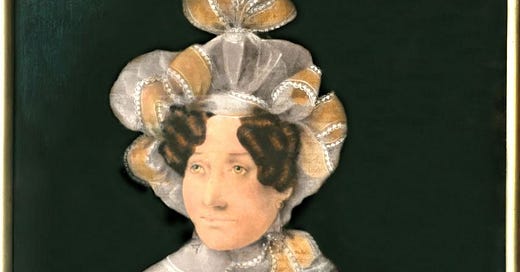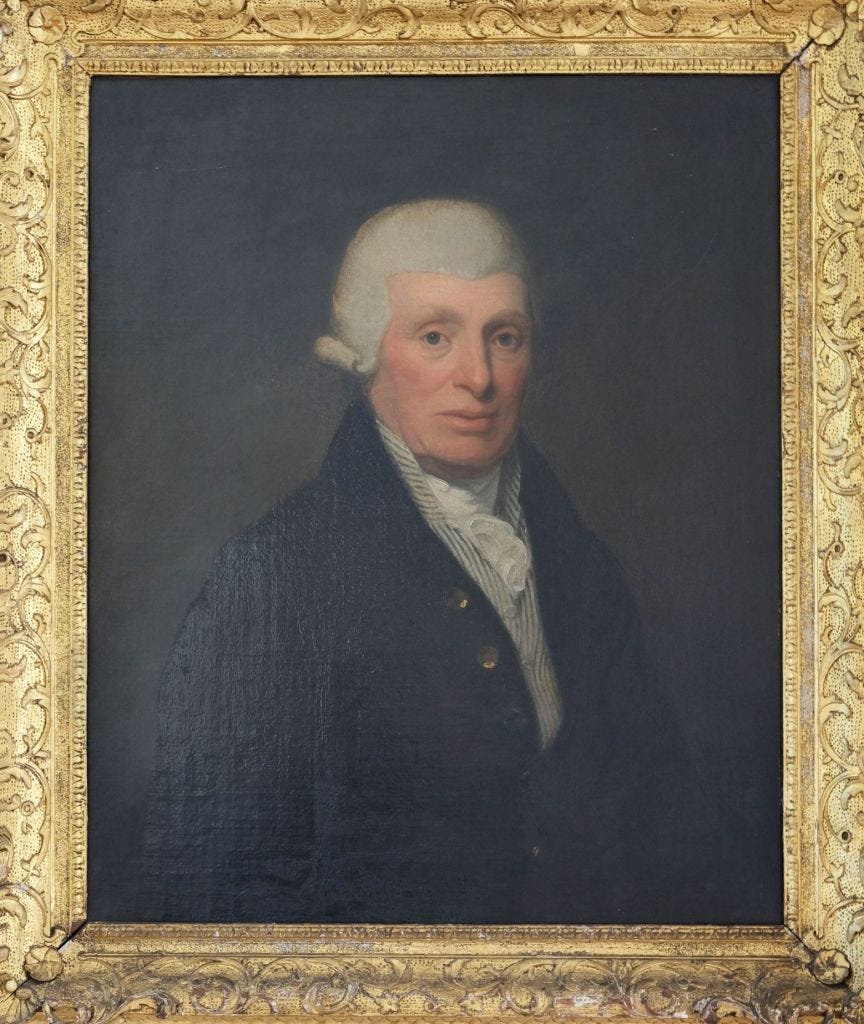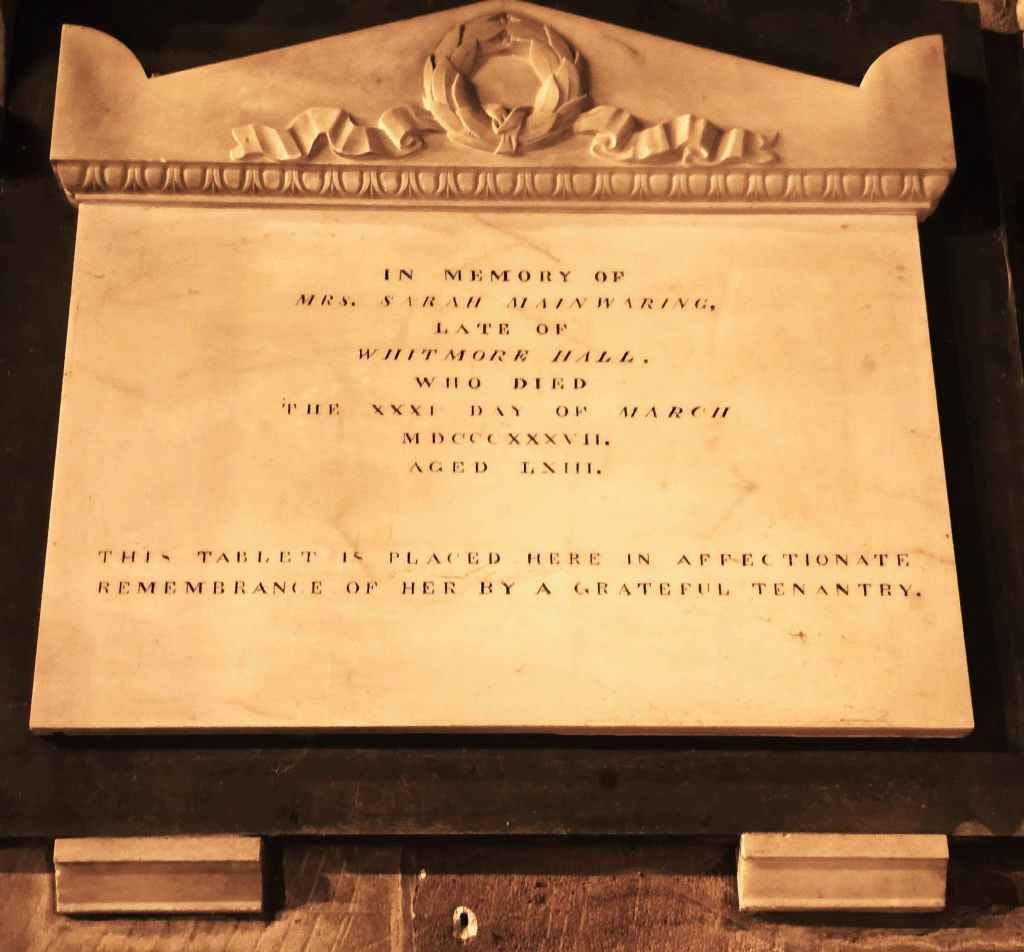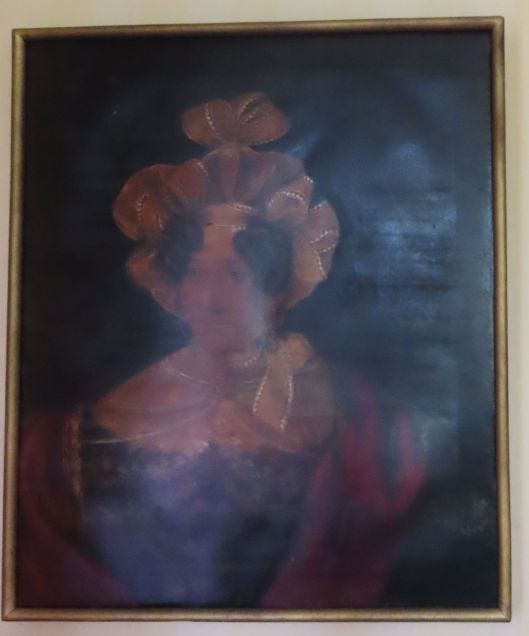Sarah Mainwaring (1774-1837) was the eldest daughter of William Mainwaring and Frances Mainwaring née Stone. She was born in 1774 and was baptised on 22 September 1774 at Saint Botolph without Aldgate, London.
Sarah’s father William (1737-1812) was the second son of Edward Mainwaring of Whitmore Hall and his wife Sarah Mainwaring née Bunbury.
William was a merchant in London and was Governor of the Hudson’s Bay Company from 1807 until his death in 1812.
William married Frances, daughter of Richard Stone, a London banker. They had five sons and six daughters:
Edward, a Cornet in the 13th Dragoons, born in 1772, and died, unmarried, of yellow fever in the West Indies in 1796
Sarah, born 1774
William, born in 1776, in the Honourable East India Company’s service, died, unmarried, at Madras in 1811
Frances Susanna, who died an infant, born 1777
Henry, of the Royal Navy, born in 1779, died, unmarried, on the 4th of June 1797, being shot in an engagement with a French frigate off Vigo, Spain, on board H.M.S. Boston
Rowland Eyton, a Captain in the Honourable East India Company’s service, born in 1780, present at the capture of Seringapatam in 1779, died, unmarried, in 1801
Anne, born 1781, married 1803 Joseph Sladen and died in 1814, leaving issue
Janet, born 1783 married 1803 Michael Russell and died in 1858, leaving issue
Charlotte, died in infancy, born 1785
Charles, born 1787, died, unmarried, in 1831
Julia, born 1789, died, unmarried, in 1851
Four of Sarah’s brothers served in either the army or the navy; all of these died comparatively young with no children. Two sisters died in infancy; two married and had children. One brother and one sister did not marry and later lived with Sarah.
Sarah’s uncle, William’s elder brother, was the eighth Edward Mainwaring of Whitmore Hall (1736–1825). He married; there were no children.
In 1817 Edward Mainwaring made a will naming Sarah’s brother Charles as heir to the “manors of Whitmore and Biddulph and the advowson of the rectory of Whitmore, all his messuages land, &c. in Whitmore, Swynnerton and Biddulph, his messuage land, &c. in Bucknall, and all other his real estates, in the county of Stafford”. He named Sarah and Charles’s cousin Rowland Mainwaring as heirs after the death of Charles.
In 1819 Edward Mainwaring added a codicil and revoked the provision in the will whereby Charles was to succeed his uncle, and gave a life estate to Sarah preceding that of her brother, he to have an annuity of £300 during the joint lives of himself and his sister, all legacies to Sarah being revoked. £100 was to be spent annually, during the life of Sarah, on repairing and making substantial and useful additions to the mansion house at Whitmore. Sarah was not to let or part with the possession of Whitmore Hall, and the furniture, books, pictures &c., were to descend as heirlooms. He revoked the legacy of £2,000 to his nephew, Rowland, in the event of his succeeding to the estate.
I do not know what Charles had done to earn his uncle’s displeasure.
In December 1825 Edward Mainwaring died and Sarah Mainwaring succeeded her uncle.
Sarah lived at Whitmore Hall with her brother Charles and unmarried sister Julia. Sarah had a companion, a Miss Chawner.
During his lifetime Sarah’s brother, Charles, appears to have acted as if he were the owner of the estates, despite Charles having been excluded by his uncle.
In 1827 Charles Mainwaring, esq. was a member of the Whitmore Association for the Prosecution of Felons on behalf of Whitmore Hall.
Charles died unmarried at Whitmore Hall in December 1831.
Sarah, referred to as Mrs Mainwaring, and her sister Julia, Miss Mainwaring, were busy in the parish, for example in 1833, for example, they were reported as supporting 2 day and Sunday schools in the parish of Whitmore. In 1835 Sarah Mainwaring was a member of the Whitmore Association.
Sarah and Julia Mainwaring and Miss Chawner of Whitmore Hall were mentioned in two 1836 letters from Emma Darwin to her sister in law Frances “Fanny” (Mackintosh) Wedgwood. Josiah Wedgwood II owned Maer Hall, three miles from Whitmore. Josiah’s daughter Emma (Wedgwood) Darwin (1808-1896) was the wife of the naturalist Charles Darwin. Fanny was her sister-in-law.
In a letter of 17 December 1836 Sarah Mainwaring’s frailty is mentioned:
We are in such a dissipated humour that we have actually invited the Mainwarings & Mrs Moreton for next Wednesday & then we shall be clear of the world for a year to come. I dined there last Tuesday & had some more of the Capts lovely flute playing. There was a Mr Clark there a clergyman from Eccleshall who played very tolerably but we were not spared a note of Capt M’s notwithstanding. Poor Mrs M. is no longer able to feed herself & I can't think how they can endure her to sit in company to be made a spectacle of with Miss Chawner putting the food into her mouth. I suppose Miss M. does not like to propose her not dining with them.(I am not sure who the Captain Mainwaring was. Rowland was in Germany at the time. Rowland’s son Edward Pellew Mainwaring had left the navy in 1835 without gaining the rank of Captain.)
Sarah Mainwaring died at Whitmore Hall on 31 March 1837.
On her death two similar marble tablets were erected, one in Whitmore and the other in Biddulph Church, bearing the following inscription:—
“In memory of Mrs. Sarah Mainwaring, late of Whitmore Hall, who died the XXXI day of March MDCCCXXXVII, aged LXIII. This table is placed here in affectionate remembrance by a grateful tenantry"Sarah Mainwaring’s will passed probate on 31 July 1837.
Sarah’s portrait hangs at Whitmore. Though it is now considerably discoloured, one of my Mainwaring cousins has photo-enhanced an image to show better what the original looked like.
In the 19th century a cap neatly covered a lady’s hair while she was at home and abroad. “Through lace, ribbons, and trimmings, ladies of the age continually reinvented the cap, transforming it from what might otherwise have been a merely utilitarian scrap of fabric into a fashionable, feminine confection.” I have found various examples of caps in portraits of the time but few as elaborate as Sarah’s.
Related posts and further reading
Z is for zigzag: concerning my fifth great grand uncle Edward Mainwaring (1736–1825), the eighth Edward Mainwaring to inherit Whitmore
A is for the Admiral: concerning my fourth great grandfather Rowland Mainwaring (1782–1862) who succeeded to the estate after Sarah
W is for the Whitmore Association for the Prosecution of Felons
From Emma Wedgwood to F. E. E. Wedgwood [28 October 1836] https://www.darwinproject.ac.uk/letter/DCP-LETT-316.xml
From Emma Wedgwood to F. E. E. Wedgwood [17 December 1836] https://www.darwinproject.ac.uk/letter/?docId=letters/DCP-LETT-328.xml
Matthews, M. (2021, July 13). Fashionable caps for 19th century matrons both young and old. Mimi Matthews. https://www.mimimatthews.com/2015/08/30/fashionable-caps-for-19th-century-matrons-both-young-and-old/
Wikitree:
Sarah Mainwaring (1774-1837)
Charles Mainwaring (1787-1831)
Julia Mainwaring (1789-1851)
Eloisa Chawner (1796-1867)
This post first published at https://anneyoungau.wordpress.com/2025/04/22/s-is-for-sarah/







That is some hat! I do love her portrait. I'd love to know what Charles did to get the ire of his father.
Sarah’s image, appearing from the gloom of her darkened portrait hanging in the hall, is captivating! Her story, spread out for us to read, is engaging!